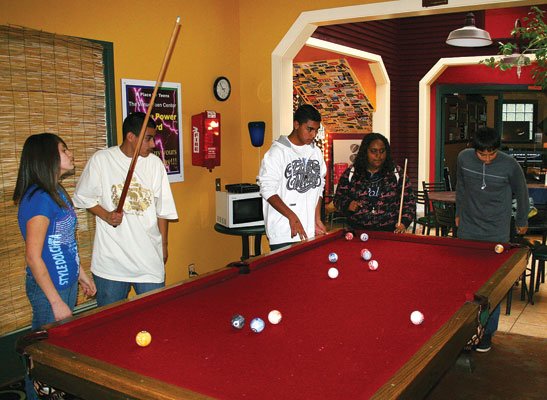Teens aim to rally businesses and community leaders for teen
center as divided council tackles pricey sidewalks, library and art
center
GIRLOY
The smell of popcorn, the cracking of pool balls and Homer Simpson’s giant yellow face on a 96-inch projection screen – they all filled the Los Gatos teen center as dozens of Gilroy High School students poured in and saw exactly what they want.
They might as well look at the best **– the “Venue” in Los Gatos cost more than $1 million to build and decorate and costs about $100,000 to run annually – on their quest to build a teen center in Gilroy, they said. The teens in this town, though, still need land, lots of money, city council support and a comprehensive nonprofit business plan before they can build what GHS students say is long overdue.
In response, the city council formed a sub-committee in January to facilitate this teen dream. Council members Peter Arellano, Cat Tucker and Dion Bracco will soon meet with the Youth Commission, Community Services Director Susan Andrade-Wax and GHS teacher Valerie Hunt.
Hunt’s 21 students say to varying degrees that they grapple with the confusing, negative influences of drugs, violence and sex. They told the council as much last year, but they have yet to brave the tedious, paper-laden path of nonprofit fund-raising. This requires business leaders, grant writers, city officials, money, time and perseverance.
“This is why we need help,” Hunt said as her students swarmed around the multi-colored, avant-garde teen center in Los Gatos last month, relishing in a dream come true.
From their mouths
“This teen center is a positive influence. Kids are easily swayed by drugs and alcohol, but they can turn to the teen center for positive influence instead,” said Lynn Prows, 17, a senior at Los Gatos High School.
As she said this, Hunt’s students milled about, coyly inspecting the center’s amenities: five high-tech computers, foosball and pool tables, an Xbox and Nintendo Wii and the most important after-school treat: food.
The pool table attracted most of the Gilroy teens, who immediately began a game. It only lasted for an hour or so, though, before they had to board the bus and return home.
“There’s too much trouble in the streets,” said Alonso Torres, 14, as he eyed the red velvet for his next shot. The freshman student in Hunt’s class was speaking about Gilroy, a city with 20,000 more residents than Los Gatos and twice as much crime, according to 2006 statistics from the Santa Clara Police Department. On the financial level, Gilroy’s median household income is $62,135, compared to $94,319 in Los Gatos, according to U.S. Census data.
Such demographic differences may seem discouraging, and GHS sophomore Charisy Mathis lamented her and her colleague’s situation, but she and others said they will remain steadfast.
“We just want somewhere to hang out, but there is nowhere to do that in Gilroy,” she said.
Dozens of others repeated the same concern around the pool table, and they all spoke with a confidence that implied determination.
“Teens need somewhere safe to go,” said Austin Clifton, 16, as her peers cracked cue balls behind her. “So many kids want this. It has to happen.”
While the Los Gatos High School students did not seem to react as the Gilroy teens cavorted, their calm demeanors suggested their unspoken comfort. Friends joked and couples snuggled on the plush, dim-lit couches as The Simpsons illuminated their faces, and laughing competitors dueled it out on the foosball table beneath Christmas lights as others darted back and forth from flat-screen computers to check their favorite social networking sites.
Where they stand,
For the past five months, Hunt and her students have consulted with community leaders, learning about their financial and real estate options.
Everything is still up in the air, but city council members have offered tentative support as they also deal with sidewalk issues and funding headaches concerning a new library and downtown arts center.
Still, Council members Peter Arellano and Cat Tucker have said the center is a high priority, and Tucker said the students in Hunt’s AVID 11 classes – a multi-grade, college-preperatory program that students apply to be in – should not waver.
“They need not get discouraged,” Tucker said. “There are a lot of interested parties, including the private sector, that can help.”
Councilman Craig Gartman agreed and said the teens should solicit business-savvy folks for money and land tips and developers and builders for construction and design advice.
“The ball is really in their court now. This is their project, and this is what they want to do,” Gartman said. “I look forward to them coming to council when they need our assistance.”
When it comes to council support, Hunt has said actions speak louder than words, but she also recognizes the need for her students to reach out to people such as Economic Develop Corporation President Larry Cope, who deals with private sector businesses daily. The EDC is more the willing to help Hunt and her students, Cope said, but first they need to determine the center’s space requirements and also hammer out a business plan for business people to consider.
“There are available properties – land and buildings – but we’re waiting for word back from Valerie (Hunt) on square footage needs,” said Cope, adding that the center will likely fill an empty building because Hunt has expressed interest in the city’s east side. Cope said he will also keep his ears open for developers interested in community projects.
Cope and Planning Commissioner Art Barron – a long-time community activist who is also a neighborhood developer for the nonprofit South County Housing – have discussed the teen center, as well, and Barron does not seem eager to roll over.
“This is personal because I have a grandson growing up in an east side neighborhood with at-risk teenagers, and my two children are teenagers,” Barron said. “These kids are dealing with a cycle of prison, drugs and alcohol, so this is long overdue in Gilroy, and I figured I can help in any way I could.”
That help has come in the form of networking, as Barron is a valuable hand-shaking resource for financially strapped groups: “Without him, I couldn’t have gotten anybody’s attention,” Hunt said.
But Barron said he can only do so much.
“These students have got to be persistent,” he said. “The city, nonprofits, and Rotary Club were all great and have stepped up and said they would help with a business plan and fund raisers, so the ball is rolling – we just have to keep the momentum rolling and not let this die.”
Gilroy Sunrise Rotary Club leader Roy Johnson did not return multiple messages seeking comment, but Gilroy Rotary Club President Jane Howard said Johnson had indeed met with Hunt to discuss the nascent project. The conversation addressed fund-raising ideas beyond the hundreds or thousands of dollars it can cost to craft a business plan and form a nonprofit group – either under the auspices of an existing nonprofit or all alone, according to Hunt.
The Gilroy Foundation, led by Donna Pray, offers grants to community groups, but the Gilroy cohort lacks the required board of directors. This is another area the group can learn from Los Gatos.
Looking to Los Gatos
The Venue, located behind the Los Gatos High School, opened 12 years ago and relies on its nonprofit board of directors, known as “A Place for Teens,” to secure funding each year. An even number of teens and adults sit on the board and decide how to raise money.
Dailing Chen, 17, plans to graduate from Los Gatos High this year and wants to attend the Rhode Island School of Design next fall, she said. Before she does this, though, she’ll finish out her term as the board’s treasurer, for which she relies on everything form the snack bar to generous grants and concert revenues – popular Emo bands such as YellowCard and Plain White T’s have played at the Venue, she noted.
The board has had trouble with funding in recent years and has had to shave hours and personnel, but when it was at its peak a few years ago, the center was open 62 hours a week and had two staff members to accommodate between 300 and 400 teens a day. Now the doors remain open about 40 hours a week, according to Los Gatos Recreation Supervisor Mike Loya, who essentially manages the Venue.
Los Gatos High School Senior Alex Chiacchi, 17, goes regularly, but he said only 20 to 30 of his grade’s 550 students hang out with him and his friends at the Venue. Still, he said, “it’s a great resource.”
“It’s the nicest place to hang out,” added his friend, Elle San Juan, 17, as the two chatted idly at a table. “It’s like my second home – it’s where I come and relax.”
This content vibe satisfies Loya, but he is also aware of Chen’s necessary fund-raising persistence.
“The nonprofit does all our fund raising and keeps this place going,” said Loya, adding that the tens of thousands of dollars in donated recording equipment the Venue has in a psuedo-sound-proofed room allows kids to record CDs for only $20 per hour: not enough to keep things going.
While no rockers were recording on a recent visit, a band of six snack-munching friends occupied the room instead, shooting each other happily as they mashed buttons on their Xbox controllers. This picturesque teenage moment would have been impossible without Los Gatos teens and their adult sympathizers squeezing money out of the city, corporations, nonprofit foundations and individuals 15 years ago.
Hundreds of fundraisers occurred for years before and after the city of Los Gatos donated the land and arranged a $1 per year lease with A Place for Teens. It took the board another three to four years to raise the necessary $1 million to build the actual center with help from construction, architectural and supply experts, according to Loya. The San Jose Sharks donated $40,000 for a new floor, and Hunt said her students were planning on a similar fund-raising effort with the San Francisco Giants this summer.
Either way, negotiating a lease and then maintaining regular funding are two distant priorities for Hunt. Underneath a skylight among a rainbow of walls and ceilings last month, her priorities seemed more immediate.
“How can you not think this is a great place to be?” Hunt asked rhetorically. “It’s like one big happy living area.”














